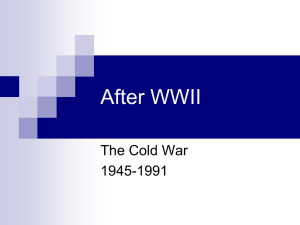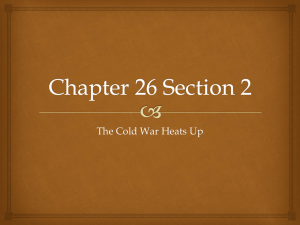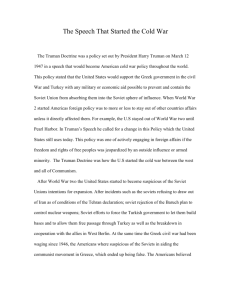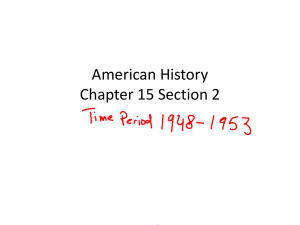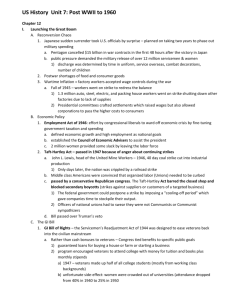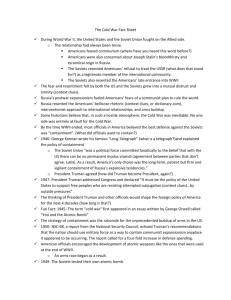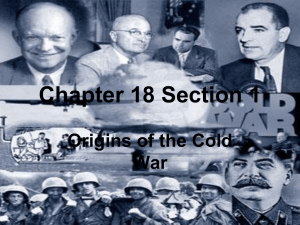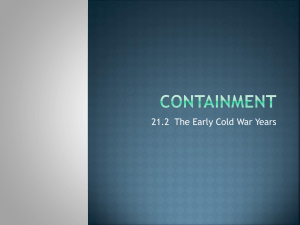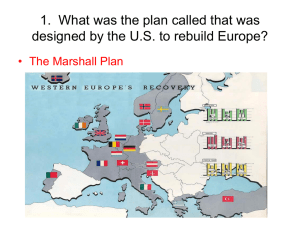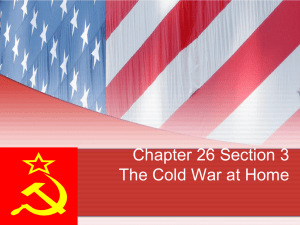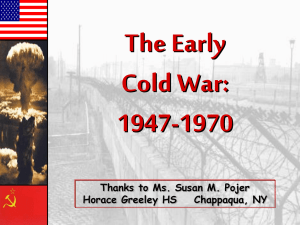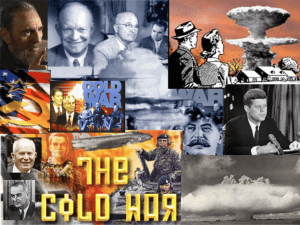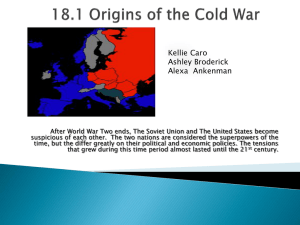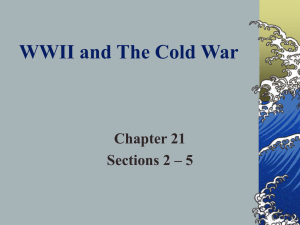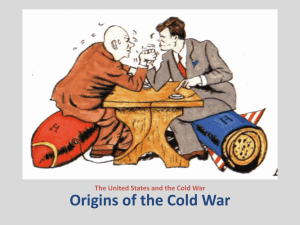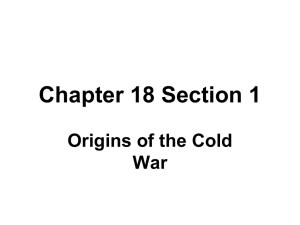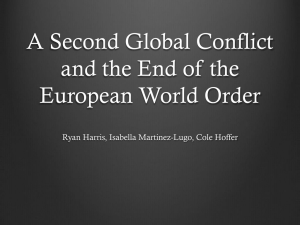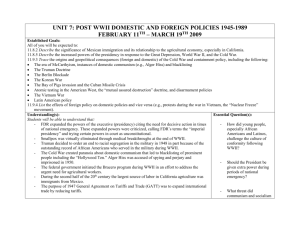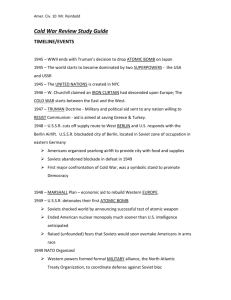US History Chapter 26 Section 1 & 2 The Cold War
advertisement
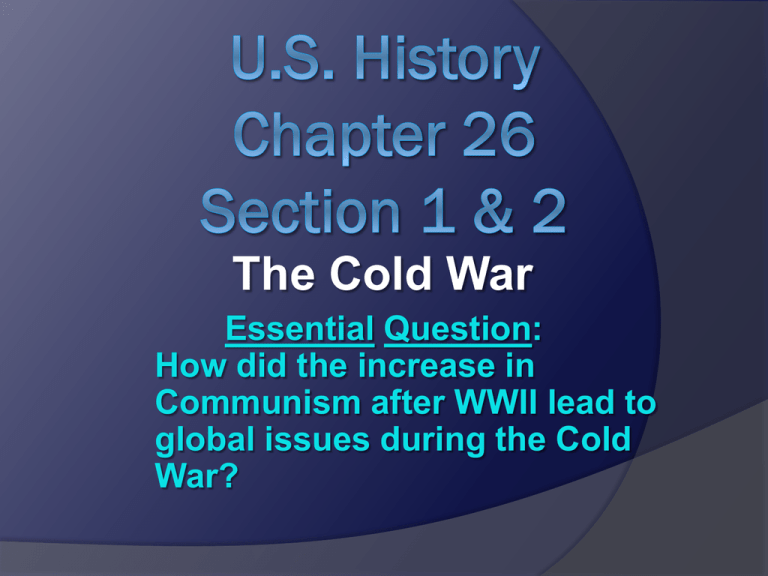
The Cold War Essential Question: How did the increase in Communism after WWII lead to global issues during the Cold War? Post World War II Much of Europe is left in ruins with little infrastructure. Japan is devastated from use of the A-bomb. Two countries with opposite political philosophies emerge as world powers. Early optimism for cooperation quickly fades into distrust and fear. Origins of the Cold War Communism vs. Democracy/Capitalism U.S.S.R vs. U.S.A What’s the problem? What makes the economic and political systems of the United States and the Soviet Union incompatible? Lingering resentment over past events. Stalin’s relationship with Hitler, Allied refusal to invade Europe in 1944, development of the atomic bomb. Despite issues, both nations join the U.N. in 1945. Yalta: Bargain or Betrayal? p. 869 Final meeting of the “Big Three” Purpose? Final plans made for defeat of Germans & what would occur to German occupied territory & E. Europe after WWII Japan? Poland? Far East/China? Plans laid for what new international peace keeping organization? A New President V.P. Harry Truman is thrust into the spotlight when FDR dies in 1945. Americans were skeptical of Truman’s ability to lead the nation. Truman had only met with Roosevelt twice in his 82 days as V.P. Truman would prove he was up to the task in his first few months as President. Truman had on the job training in dealing with leaders like Stalin and Churchill. Conflicting Goals in Europe United States vs. Soviet Union How do the post WWII goals of the USA & USSR conflict? What does each country want to promote in Europe? Soviet Satellite Nations Due to extreme causalities and extensive damage from WWII, Soviets feel vulnerable to attack from the West. Soviet’s want to control neighboring countries. Satellite nations will be dependent upon Soviet Welfare. Stalin props up governments in Albania, Bulgaria, Hungary, Czechoslovakia, Romania, Poland, the Baltic States and other countries all over E. Europe. The Containment Policy Time to stop “babying the Soviets” U.S. diplomat George Kennan proposes policy of Containment. U.S. efforts to block the spread and influence of Soviet communism during the late 1940s and early 1950s. Must stop the domino effect of communism. Containment will guide Truman’s foreign policy. U.S. Containment Efforts Truman Doctrine – 1947 U.S. will support free peoples resisting takeovers by “armed minorities or outside pressures.” a.k.a. communists The U.S. will provide economic and military aid to free nations threatened by internal or external components (communism). Begins with aid to Turkey and Greece. Marshall Plan - 1947 W. Europe is devastated No work, no infrastructure, millions are homeless. The primary purpose of the Marshall Plan was to aid the economic recovery of war-torn Europe What’s the catch? Congress debates for months, what happens to ensure the Marshall Plan’s passage? George Marshall Welches, mit Deutschland zu machen? Germany divided into four zones. Soviets want Germany weak and divided. U.S., France, and Britain believe Europe will be more stable if Germany is reunited. 1948 Western Zones are combined into one nation. E. Germany becomes a Soviet Satellite. Berlin Airlift Soviets blockade West Berlin American and British officials fly food and supplies to W. Berlin to break the blockade. Nearly 30,000 flights over the course of 327 days brought 2.3 million tons of supplies to W. Berlin. Flights took off and landed every few minutes and went around the clock. Berlin Airlift humiliated the Soviets and they eventually lifted the blockade. Warsaw Pact • Formed by the Soviet Union and their E. European satellites when W. Germany rearms and joins NATO. • Warsaw Pact is an alliance just like NATO Essential Question: How did the increase in Communism after World War II lead to domestic issues during the Cold War? After WWII what / who do Americans fear most of all? • Post WWII Americans fear that communism is taking over the world. • Americans also fear nuclear war with the Soviet Union The House Un-American Activities Committee (HUAC) Based on the Loyalty Review Board Developed by congress to search out disloyalty before WWII. HUAC first made headlines when began to investigate Communist influence in the movie industry in 1947. Walt Disney, Ronald Reagan, Ayn Rand among those questioned. Hollywood vs. Washington D.C. “Reds” in our midst? The Hollywood Ten HUAC subpoenas 43 witnesses from Hollywood. Many are “friendly” and cooperate with HUAC. 10 are “unfriendly” refuse to name names Thought hearings were unconstitutional. Results in being Blacklisted. Spy Paranoia USSR detonates A-bomb in 1949, three years ahead of schedule. How did Soviets make up so much ground so quickly? Somebody gave the Soviets inside info about America’s atomic bomb development. Alger Hiss Investigated by the HUAC, Hiss was the first American to be indicted for spying post WWII. Convicted of perjury in 1950. Would set the stage for the future events. Spread of communist fear second red scare. Who led the charge against Alger Hiss? Ethel & Julius Rosenberg Executed for espionage in 1953. Convicted of giving American atomic secrets to the Soviets. Rosenberg's were members of the American Communist Party How did the spy cases involving Alger Hiss and the Rosenbergs effect the domestic environment of post WWII United States?
